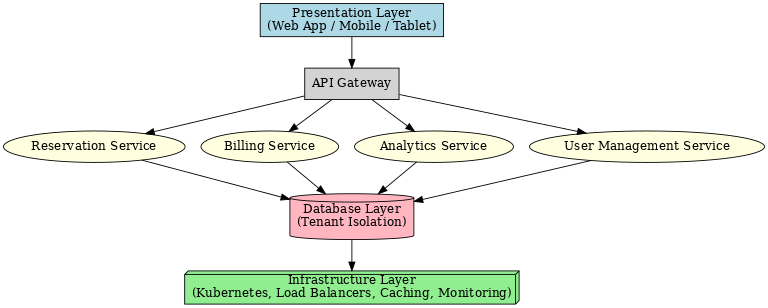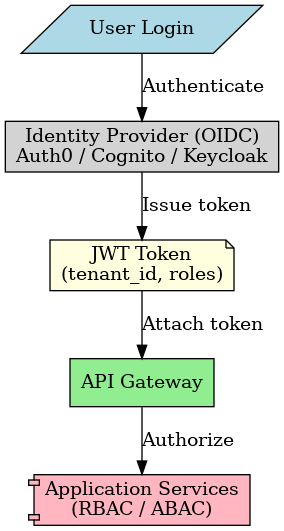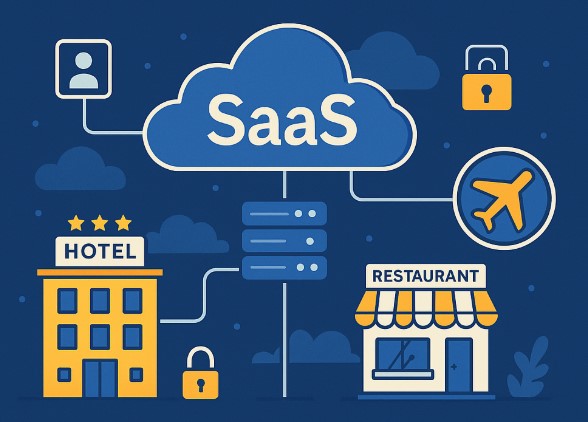Cloud computing has revolutionized how businesses consume software. Instead of purchasing and installing software per organization, companies increasingly adopt Software-as-a-Service (SaaS) platforms that can serve thousands of customers through a single codebase.
When building internal management systems for Hotels/Resorts, Restaurants, and Travel Agencies, adopting a multi-tenant SaaS architecture becomes a game-changer. It optimizes costs, simplifies operations, and delivers an efficient, personalized experience for each tenant while still maintaining strong isolation and scalability.
This article takes a deep technical dive into multi-tenant SaaS design, from tenancy models and data isolation strategies to observability, scaling, and per-tenant customization. We’ll then apply these lessons to three practical systems:
- Hotel/Resort Internal Management System
- Restaurant Internal Management System
- Travel Agency Internal Management System
Understanding Multi-Tenant SaaS Architecture
What is Multi-Tenancy?
In software terms, tenancy refers to how data and configurations are organized per customer. In a multi-tenant architecture, multiple customers (tenants) share the same software instance while being logically isolated from each other.
Benefits:
- Efficiency: Shared infrastructure lowers costs.
- Centralized updates: One codebase → easier upgrades.
- Scalability: Cloud-native scaling across all tenants.
- Faster onboarding: Tenants can sign up instantly without new deployments.
Tenancy Models: Choosing the Right Approach
a) Shared Schema (single DB, row-level isolation)
- How it works: All tenants share the same DB tables. Each row has a tenant_id.
- Pros: Cost-efficient, simple to scale.
- Cons: Risk of “noisy neighbors.”
- Best for: Small tenants with lightweight needs.
b) Schema-per-Tenant
- How it works: One database, but each tenant has its own schema.
- Pros: Better logical isolation, easier migrations.
- Cons: More metadata management.
- Best for: Medium tenants that need independence but not dedicated infra.
c) Database-per-Tenant
- How it works: Each tenant gets its own database instance.
- Pros: Maximum isolation, good for compliance (GDPR, PCI).
- Cons: Most expensive and hardest to operate.
- Best for: Enterprise tenants with sensitive data or custom needs.
| Model | Description | Pros | Cons | Best Use Case |
|---|---|---|---|---|
| Shared DB, Shared Schema | All tenants in same tables with tenant_id column | Cost-efficient, simple scaling | Risk of noisy neighbors, strict RLS needed | Small tenants |
| Shared DB, Separate Schemas | Each tenant has its own schema inside same DB | Better logical isolation, easier migrations | Metadata overhead | Medium tenants |
| Separate DB per Tenant | Each tenant gets its own DB instance | Strongest isolation, compliance friendly | Expensive, heavy ops | Large tenants |
Hybrid Approach
Start with shared schema for small tenants, and promote larger tenants to schema-per-tenant or DB-per-tenant. This balances cost and compliance.

Tenant Resolution & Routing
In a multi-tenant SaaS environment, tenant resolution and routing are critical to ensuring that every request is mapped to the correct tenant context before execution. Without proper tenant resolution, there is a risk of data leakage or misrouting of operations, which can compromise both security and reliability.
The tenant identifier (tenant ID) is the key element in this process. It defines which tenant’s data and configuration should be applied for a given request. There are several common approaches to resolving tenant IDs. One is through subdomains (e.g., hotelX.app.com, which resolves to tenant = hotelX). Another is through custom domains (e.g., booking.hotelX.com). A third, less common method, is using a request header, such as X-Tenant-ID, which is often applied in internal or API-based integrations.
Once the tenant ID is identified, middleware is typically responsible for injecting it into the request context, so that downstream services and database queries know which tenant’s data to access. In Express.js, this can be implemented as follows:
// tenantResolver.js
function tenantResolver(req, res, next) {
let tenantId;
// Subdomain approach
const host = req.hostname.split('.');
if (host.length > 2) {
tenantId = host[0];
// e.g., hotelX.app.com → tenant = hotelX
}
// Header approach (fallback)
if (!tenantId && req.headers['x-tenant-id']) {
tenantId = req.headers['x-tenant-id'];
}
// Attach tenantId to request context
if (tenantId) {
req.tenantId = tenantId;
next();
} else {
res.status(400).json({ error: "Tenant ID not resolved" });
}
}
module.exports = tenantResolver;
With this middleware, every request is intercepted, the tenant ID is resolved based on subdomain or headers, and it is injected into req.tenantId. All downstream logic—such as database queries or service calls—can then enforce strict tenant isolation, ensuring data security and personalized tenant experiences.
Authentication & Authorization
In a multi-tenant SaaS architecture, authentication and authorization are fundamental to ensuring both secure access and tenant isolation. Modern platforms typically integrate with an identity provider such as OIDC-compliant systems like Auth0, AWS Cognito, or Keycloak. These providers handle user identity management, tenant-aware logins, and token issuance.
For token design, JSON Web Tokens (JWTs) are widely used. A JWT payload usually contains essential claims such as the tenant_id, user identifier (sub), and assigned roles. For example:
{
"sub": "user:4321",
"tenant_id": "123",
"roles": ["tenant_admin", "staff"],
"exp": 1690000000
}

Authorization can then be enforced using Role-Based Access Control (RBAC), where each tenant has roles like admin, manager, or staff. In more advanced scenarios, Attribute-Based Access Control (ABAC) can be applied to enforce granular rules, such as restricting access based on branch, department, or region.
Finally, for operational support, some systems implement impersonation features, allowing support staff to log in as tenant users for troubleshooting. However, this must be strictly auditable, with logs capturing when and why impersonation occurred to maintain transparency and trust.
Data Security & Compliance
Data security is a core requirement in a multi-tenant SaaS environment. Row-Level Security (RLS) ensures tenant isolation at the database level by enforcing tenant-specific filters. This guarantees that users can only access their own data, even when multiple tenants share the same database.
Strong encryption practices must be in place across the platform. At rest, data should be secured using cloud-native Key Management Services (KMS). In transit, TLS must be enforced everywhere to protect communication channels. For tenants requiring higher levels of compliance, per-tenant encryption keys can be adopted.
For handling financial transactions, payment gateways such as Stripe or Adyen should be integrated. Only secure tokens should be stored, never raw card data. Additionally, compliance with regulations like GDPR is essential. This includes providing APIs for per-tenant data deletion and export, ensuring transparency and user control over personal data.
| Aspect | Technique | Example |
|---|---|---|
| Tenant Isolation | Row-Level Security (RLS) | Postgres RLS with tenant_id |
| Encryption | KMS at rest, TLS in transit | AWS KMS, TLS 1.3 |
| Payments | Tokenization via PSP | Stripe/Adyen |
| Compliance | GDPR APIs for data delete/export | /api/tenant/export |
Scaling & Performance
A multi-tenant SaaS system must balance workloads across many tenants, each with very different usage patterns. To achieve elasticity, the application layer is typically deployed on Kubernetes, with Horizontal Pod Autoscaling (HPA) configured to scale pods up or down based on CPU, memory, or custom metrics (like requests per second). This ensures that during peak check-in hours at a hotel or dinner rush at a restaurant, additional compute capacity is provisioned automatically.
On the database side, scaling strategies must prevent bottlenecks. Shared databases should leverage read replicas to offload analytics queries and reporting tasks, preserving performance for transactional workloads. For resource-intensive tenants, data can be migrated to dedicated databases, preventing noisy-neighbor issues and providing performance isolation.
Caching is another critical layer for responsiveness. Systems like Redis can be used to cache frequent queries and session data, with keys namespaced per tenant (e.g., tenant:123:cache:…) to avoid conflicts. This not only reduces latency but also minimizes database load.
const cacheKey = `tenant:${tenantId}:reservations:${reservationId}`;
await redis.set(cacheKey, JSON.stringify(reservationData));For tasks that don’t need synchronous responses—such as generating reports, synchronizing third-party integrations, or sending notifications—asynchronous processing should be used. Message brokers like Kafka or RabbitMQ allow jobs to be queued and processed by worker services, always tagged with a tenant_id in message headers to ensure tenant-specific handling.
Finally, to maintain fairness and prevent overuse, rate limiting and quota enforcement must be applied at the API gateway level. This ensures that a large tenant cannot monopolize system resources, while smaller tenants still receive guaranteed service levels. Together, these scaling strategies enable consistent, predictable performance even as the platform grows.
Database Migrations
In a multi-tenant SaaS platform, database migrations must be carefully managed to avoid downtime or tenant disruption. The safest approach is to follow backward-compatible steps. First, new columns or tables should be added in a way that does not break existing queries. Once the schema is extended, data can be backfilled asynchronously, ensuring tenants continue using the system without interruption while historical data is migrated in the background.
After the backfill process is complete, the application can be updated to start using the new schema or fields. Only once the system is fully stable and tested should the old schema elements be removed, reducing risk and giving room for rollback if needed.
For tenants using separate schemas or dedicated databases, migrations must be executed tenant-by-tenant, with their progress tracked individually. This allows large tenants to be updated in controlled batches, while smaller tenants can be migrated quickly. Keeping a migration status log per tenant ensures visibility into which databases have been upgraded and helps recover gracefully if any step fails.
-- Step 1: Add new column
ALTER TABLE bookings ADD COLUMN booking_source TEXT;
-- Step 2: Backfill asynchronously
UPDATE bookings SET booking_source='website' WHERE booking_source IS NULL;
-- Step 3: Switch app to use new column (code-level change)
-- Step 4: Cleanup (remove deprecated column after safe period)
ALTER TABLE bookings DROP COLUMN old_source;

Observability
Observability in a multi-tenant SaaS platform ensures visibility into both system health and tenant-specific performance. Distributed tracing using OpenTelemetry should always tag traces with tenant_id, making it easy to isolate issues for specific tenants. Structured logging must include identifiers such as {tenant_id, request_id, user_id}, allowing precise debugging and correlation across services. Metrics should capture latency, error rates, and usage on a per-tenant basis to highlight hotspots or imbalances. On top of this, alerts should be SLA-driven, configured both globally and at the tenant level, so critical failures or SLA breaches are detected immediately.
with tracer.start_as_current_span("booking_request") as span:
span.set_attribute("tenant_id", tenant_id)
span.set_attribute("request_id", request_id)
Billing & Metering
To support fair usage and cost transparency, the system should generate usage events for activities such as API calls, bookings, and storage consumption. These events flow through a billing pipeline (e.g., Kafka → usage processor → billing database). With proper tagging of cloud resources and workloads by tenant, the system can achieve per-tenant cost attribution, enabling accurate invoicing and cost visibility. This also allows the platform to enforce quotas and support flexible billing models like pay-per-use or subscription tiers.

| Tenant | API Calls | Storage Used | Billable Amount |
|---|---|---|---|
| HotelX | 120,000 | 40 GB | $1,200 |
| DineY | 30,000 | 10 GB | $350 |
| TravelZ | 300,000 | 150 GB | $3,900 |
Operational Lifecycle
The onboarding process begins by creating tenant metadata, provisioning the appropriate database or schema if required, and seeding default configurations and sample data for a quick start. For offboarding, tenant data should first be exported, and then permanently deleted after retention policies are met, ensuring compliance with regulations like GDPR.
Backups must be carefully designed: shared databases require global backups with selective tenant restore capabilities, while DB-per-tenant setups allow straightforward per-tenant snapshots. For disaster recovery, the platform should use multi-region replicas and DNS failover strategies to ensure continuity even in case of regional outages.

Event-Driven & Microservice Patterns
A robust SaaS platform benefits from an event-driven architecture. Core services such as authentication, tenant management, and billing are shared across all tenants, while domain-specific services—such as booking, POS, inventory, and CRM—are built as independent microservices. An event bus (like Kafka) decouples these workflows: for instance, a booking_created event can trigger inventory updates and notifications asynchronously. To maintain tenant integrity, every event must carry the tenant_id in its metadata, ensuring proper routing and isolation across the system.

Customization & Feature Flags
Multi-tenancy must balance standardization with personalization. A configuration store holds tenant-specific settings such as branding, workflows, and pricing rules. Feature flags allow selective activation of features per tenant, using tools like Unleash or LaunchDarkly, making it easy to roll out features gradually or provide premium capabilities. On the user side, UI customization applies tenant-specific themes, logos, and color schemes during load time, ensuring each tenant’s users feel they are working within their own dedicated environment.
Application of Multi-Tenant SaaS in Hospitality & Travel
Now that we’ve covered the deep technical backbone, let’s bring it into practice. How do we apply multi-tenancy to Hotel/Resort, Restaurant, and Travel Agency Internal Management Systems?
1. Hotel / Resort Internal Management System
Hotels and resorts juggle multiple operations: reservations, housekeeping, guest services, billing, staff scheduling, and facilities management.
Multi-Tenant SaaS Benefits:
- Tenant Isolation: Each hotel/resort has its own branded portal. A boutique resort in Bali and a chain of resorts in Europe share the same platform but experience unique branding and workflows.
- Dynamic Scalability: Resorts with peak-season loads (e.g., Maldives in summer) can automatically scale without manual intervention.
- Modules Optimized via Microservices:
- Reservation System
- Room Management & Housekeeping
- Staff Scheduling
- Guest Services & Feedback
Example:
A resort with 500 rooms uses the same platform as a 30-room boutique hotel. The SaaS system auto-scales for the larger tenant and ensures seamless guest check-ins, while the smaller hotel enjoys the same advanced tools at a fraction of the cost.
2. Restaurant Internal Management System
Restaurants require smooth operations in menu management, table reservations, POS integration, staff shifts, and supply chain monitoring.
Multi-Tenant SaaS Benefits:
- Shared Infrastructure, Customized Menus: Each restaurant customizes menus and layouts without needing dedicated infrastructure.
- Analytics as a Service: Owners access insights like top-selling dishes or peak dining hours without managing servers.
- Multi-Device Access: Waiters use tablets, managers use dashboards, and chefs see orders on a kitchen display system—all powered by the same SaaS.
Example:
A fast-food chain with branches across countries gets a centralized dashboard to monitor performance, while a single-location fine-dining restaurant uses the same SaaS at a smaller scale.
3. Travel Agency Internal Management System
Travel agencies handle bookings, itineraries, agent commissions, customer profiles, and vendor relationships.
Multi-Tenant SaaS Benefits:
- Centralized Booking Engine: Shared infrastructure for managing flights, hotels, and tours, with tenant-level customization.
- Customer Personalization: AI-driven recommendations based on each agency’s clientele.
- Secure Vendor Integrations: APIs for airlines, resorts, and transport providers—all isolated by tenant.
- Scalable Growth: A small local agency and a global corporate agency both run on the same core system without infrastructure worries.
Example:
A Sri Lankan travel agency specializing in cultural tours and a multinational agency specializing in luxury cruises both use the platform but see completely different branding, workflows, and analytics tailored to their business model.
Why Multi-Tenant SaaS Optimizes User Experience
- Cost Efficiency → Businesses avoid upfront infrastructure costs and pay only for usage.
- Seamless Updates → New features roll out globally without downtime.
- High Availability → Load balancing ensures minimal latency for tenants worldwide.
- Customization without Complexity → Each tenant sees unique branding, workflows, and data, while still being part of the shared system.
- Data Security → Strong isolation mechanisms ensure compliance with GDPR, HIPAA, or PCI DSS, depending on tenant needs.
Conclusion
Multi-tenant SaaS architecture is more than just a hosting strategy—it is the backbone that enables scalability, cost-efficiency, and personalization across diverse industries like hospitality, food service, and travel. By carefully combining tenant resolution, authentication, data isolation, security, scaling mechanisms, observability, and lifecycle automation, a single platform can seamlessly support thousands of tenants, each with unique branding, workflows, and compliance needs. For hotels and resorts, this means streamlined reservations and operations; for restaurants, it ensures smooth POS and kitchen coordination; and for travel agencies, it delivers secure and personalized booking experiences. With the right mix of technical rigor and thoughtful design, multi-tenant SaaS empowers businesses of all sizes to access enterprise-grade software, while continuously evolving through feature flags, modular microservices, and AI-driven insights. Ultimately, this architecture transforms cloud applications into future-proof ecosystems, where efficiency, security, and user experience go hand in hand.



